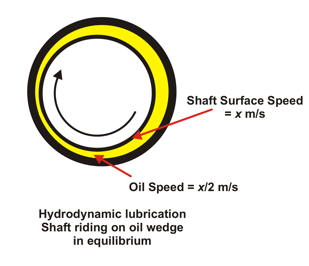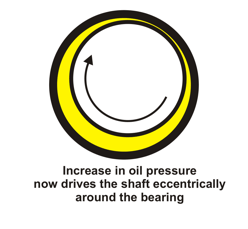Oil Whirl
A sudden increase in speed or an external shock can cause the eccentricity of the shaft to increase from its equilibrium position. Oil is immediately pumped into the space vacated by the shaft which increases the pressure of the oil film, creating additional force between the oil film and shaft. The oil film now drives the shaft ahead of it in a forward circular motion within the bearing clearance. The frequency of the vibration set up by this whirling is just below 50% of shaft speed. Likelihood of oil whirl occurring after a disturbing force causes the shaft to move from equilibrium is increased by an excessive bearing clearance or oil at the wrong viscosity or pressure. Note: Tilting pad journal bearings (often used on prop shaft bearings) do not suffer from whirl.
Oil Whip
Oil whip occurs when the oil whirl frequency coincides with the rotating shafts natural frequency. Resonance occurs and the amplitude of the vibration increases - limited to the bearing clearance. At this point, the oil whip frequency remains the same, independent of the rotor speed. If allowed to continue, bearing failure will occur within a short time.
The following related articles are available in the Members Section Thickwall Bearings Main Bearing Design Bottom End Bearing design Crosshead Bearing Design The Piston pin Bearing The Thrust Bearing Bearing Faults |



